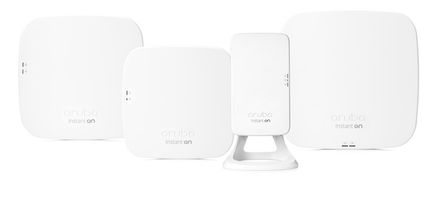
Small businesses come in many flavors. To best meet your business Wi-Fi needs, Aruba offers five Aruba Instant On access points (APs) to satisfy a variety of the ways and places Wi-Fi is used. The trick is to decide which model to use and when.
Here is a little guidance to help you choose.
1. Are you a small business?
Aruba Instant On APs are intended for smaller businesses and locations that range from 1 to 99 users. It doesn’t matter what type of business or site.
Here are some environments Aruba Instant On will likely fit quite well:
- Independent restaurants
- Smaller retailers (clothiers, dry cleaners, beauty shops and parts stores)
- Workout and gym facilities
- Small offices (realty, car dealerships, accounting and tax firms)
- Dentist offices and urgent care clinics
- Non-profits like church or service agencies
- Technology start-ups
- Boutique hotels
2. What Wi-Fi usage do you expect?
It’s important to anticipate the type and amount of traffic that will be on your Wi-Fi network. Consider the groups that will be using Wi-Fi and how busy they will be with their Wi-Fi connections. Are they likely to send and receive a lot of data or will they be light users of the network? Will there be peak times when everyone accesses the network at once, or will usage be fairly evenly spread throughout the workday?
With Aruba Instant On, we offer a choice of “good,” “better” and “best” access points to align with your business needs. For “good” Wi-Fi, the AP11 is perfect for light network usage, with individuals accessing vanilla apps like email and web content and no peak times for usage. Our “better” offering – the AP12 – can handle more, be it intense network users that spread their work over the day, or light users that might connect at the same time. Our “best” offering – the AP15 – will work with intense Wi-Fi network usage, where lots of individuals are accessing advanced apps with multiple video streams and voice calls stressing the network, all at the same time.
You want to build your Wi-Fi network to match the peak usage demands. If you expect lots of devices to connect via Wi-Fi at once or see the use of advanced apps like voice and video, you’ll want to build your network with higher-end APs that support higher densities and bandwidth needs.
3. Location, location, location.
Before you decide which Aruba Instant On model is right for you, you need to consider where the APs will be installed. The most common installation of indoor APs is on the wall or ceiling, as this provides the best coverage.
For small spaces, a desktop or even “in wall” placement of an AP may be sufficient. The Aruba Instant On AP11D is the perfect fit.
For outdoor locations that need Wi-Fi coverage, it’s an easy choice as there’s only the Aruba Instant On AP17. It’s built to weather the storm, snow or a hot summer day.
Aruba Instant On access points can be mixed and matched to support a variety of needs, but it’s often wise to use the same model for indoor use. That way, there is consistent traffic flow between APs of like performance. APs can be easily reused if you need to replace a unit that isn’t working. And it makes it easy for the person who supports your network.
4. Will you mesh Wi-Fi?
Mesh is a technology that allows you to extend Wi-Fi to reach hard to cover locations where you don’t have a hardwired connection. In an ideal network, all the Wi-Fi APs have a wired connection to the network and out to the Internet. But sometimes you must provide Wi-Fi to a location where there isn’t a convenient way to connect the AP with a wire. Instant On Smart Mesh easily solves this. You connect the bulk of your Wi-Fi APs with cables, then you install an AP local to that isolated group and it uses its Wi-Fi radios both to connect to local users and to connect up to another AP on the wired network. Problem solved.
All of Aruba Instant On APs support this mesh capability. But keep in mind: If you are going to use mesh instead of cabling each AP to a switch, the APs operating in mesh mode lose usable bandwidth as they maintain their relationship to the primary AP over Wi-Fi. In these cases, a better AP will perform more robustly. Consider choosing an AP at both ends faster than what you might otherwise choose for a hardwired AP.
Choosing the Right APs: Good, Better and Best
Let's review the different models.
The “Good” Access Point – AP11
Aruba’s Instant On AP11 provides great performance for indoor locations with modest numbers or groups of up to 25 users. Traffic consists of less critical, non-constant and non-intense Wi-Fi usage. Device densities of up to 50 simultaneous devices are supported. The best fit:
- Office area with up to 25 Wi-Fi users where smart phones or VoIP handsets are primarily used. Printers are still plugged into Ethernet ports. Email and light traffic is the norm.
- Small restaurants where guests are surfing the Internet and maybe there’s one wireless-enabled point-of-sale (POS) device.
- The waiting area of an automotive repair or beauty, dentist office or small law firm
- Small non-profit or church administrative office
The AP11 is an 802.11ac Wave 2 access point, with 2x2 radio and antenna stream support. This makes it fast, cost effective, and flexible. The APs can be wall- or ceiling-mounted, and ship with two types of mounting brackets – one for flat-surface mounting and one for drop-ceiling-rail mounting. They can be powered using Power over Ethernet (PoE) or with an optional A/C power adapter.
The “Better” Solution – AP12
Aruba’s Instant On AP12 provides a robust performance improvement for indoor locations with groups of 50 or so users, or slightly smaller numbers with more intense networking requirements. Device densities of up to 75 simultaneous devices at a time are supported. The best fit:
- Decent size law or accounting firms that have transitioned to cloud storage services and Wi-Fi-enabled communications apps
- Doctors’ offices with larger guest waiting rooms and a mixture of up to 50% of their client devices supporting Wi-Fi
- A car dealership where business and back-end apps are primarily Wi-Fi- enabled
- A small event venue where social media apps with uploads are the norm
The AP12 is an 802.11ac Wave 2 access point, with 3x3 radio and antenna stream support. Its performance will be better than the AP11 and a slightly higher cost. The AP12 can also be wall- or ceiling-mounted, and ships with same mounting brackets as the AP11. They too can be powered using PoE or with the optional A/C power adapter.
The “Best” Solution – AP15
Aruba’s Instant On AP15 provides very robust performance for indoor locations with groups of 75 or so Wi-Fi users with high intensity networking needs. Device densities of up to 100 simultaneous devices at a time are supported. The best fit:
- Larger healthcare clinic with business, medical and patient Wi-Fi access. Over 50% of the devices are Wi-Fi-enabled, such as printers, cameras and medical equipment.
- Graphic design firms that create video and audio content and have large uploads to storage.
- Technology startups with heavy unified communications and storage needs
- Larger venues that cater to shared businesses or have heavy guest access
- Any business that sees large amounts of gaming
The AP15 is an 802.11ac Wave 2 access point, with 4x4 radio and antenna stream support. This is the highest performing AP today in the Aruba Instant On portfolio.
The AP15 can also be wall- or ceiling-mounted. The wall-mount bracket is slightly bigger than those of the AP11 and AP12 to accommodate cabling. The AP15 can also be powered using PoE or an optional A/C power adapter.
Wi-Fi in Small Areas: Desktop or Wall-Mounted APs
Aruba’s Instant On portfolio includes a model that can be desktop- or wall-mounted. The AP11D access point is for smaller areas needing Wi-Fi where desktop or wall-mounting offers added convenience. These APs also offer the advantage of having additional Ethernet ports that can be used for directly connecting devices such as a PC or printer. The best fit:
- Executive office with isolated users that require a private printer or hardwired VoIP extension
- Conference rooms
- Small business such as a flower shop or other retailer where a printer or POS device is directly connected
- In-room hotel or motel use
The AP11D is an 802.11ac Wave 2 access point, with 2x2 radio and antenna stream support. It has four built-in Ethernet ports, where one intended as its uplink and three used for local connections. The AP11D ships with the desk stand pre-installed on the AP so it can sit on a desktop or shelf. An additional wall box mount is included for attaching to a wall.
The AP11D provides great performance for indoor locations with modest numbers or groups of up to 25 users. Up to 50 simultaneous devices at a time are supported. Care should be taken to install the AP in a location close to the center of the intended coverage area and free from obstructions or sources of interference.
The Aruba Instant On AP11D can be powered via PoE or with an optional A/C power adapter. If powered by PoE+, one of the downlink ports will also forward PoE power to any attached device.
There is one other notable AP11D application. With Instant On’s latest software capabilities, all Aruba Instant On APs can be used as a gateway, meaning they can often replace a separate router or gateway device. The AP11D among them is unique, though, in that it has an uplink connection as well as downlink ports for further networking. It is the preferred choice for an initial gateway device.
Outdoor Wi-Fi
The Aruba Instant On AP17 is an outdoor model that is built to handle the weather. Here are a few examples where this might be a fit:
- Outdoor café areas
- Car dealerships where “on the lot” access is needed
- Pool area of a small hotel or B&B
- Open air venues of any type
The AP17 is an 802.11ac Wave 2 access point with 2x2 radio and antenna stream support. It is capable of supporting 25 or so Wi-Fi users, with supported client densities up to 50 simultaneous devices.
Many Ways to Get Your Best Fit for Wi-Fi
With the Aruba Instant On family of Wi-Fi access points, your business can choose the right access point for your specific needs. Choosing the right model requires a little effort. You must decide whether you need Wi-Fi indoors, outdoors or in smaller areas. Next, judge your network performance needs. And decide if you intend to mesh. In the end, by following these simple steps, you’ll have the happy users you want without breaking the bank.